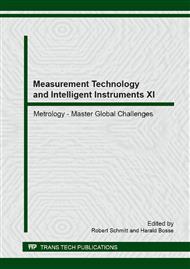[1]
ISO 3650-1998, Geometrical Product Specifications (GPS) – Length standards – Gauge blocks, second edition, (1998).
DOI: 10.3403/01722616u
Google Scholar
[2]
Decker J.E. and Pekelsky J.R., Uncertainty evaluation for the measurement of gauge block by optical interferometry, Metrologia, 34 (1997), p.479 – 493.
DOI: 10.1088/0026-1394/34/6/4
Google Scholar
[3]
Hamid R., Sendogdu D., Erdogan C., The temperature stabilization and temperature measurement of a Kösters interferometer, Meas. Sci. Technol. 16, (2005), p.2201 – 2207.
DOI: 10.1088/0957-0233/16/11/010
Google Scholar
[4]
Darnedd H., High precision calibration of long gauge blocks using the vacuum wavelength comparator, Metrologia, 29 (1992), p.349 – 359.
DOI: 10.1088/0026-1394/29/5/005
Google Scholar
[5]
Lewis A., Measurement of length, surface from the thermal expansion coefficient of length bars up to 1. 5 m using multiple-wavelength phase-stepping interferometry, Meas. Sci. Technol. 5 (1994), pp.694-703.
DOI: 10.1088/0957-0233/5/6/009
Google Scholar
[6]
Decker J. E. and Pekelsky J. R., Gauge Block Calibration by Optical Interferometry at the National Research Council of Canada Measurement Science Conference Pasadena NRC, International Report No. 40002 (1997).
Google Scholar
[7]
M. Okaji, N. Yamada and H. Moriyama, Ultra-precise thermal expansion measurement of ceramic and steel gauge block with an interferemetric dilaometer, Metrologia (2000), p.165 – 171.
DOI: 10.1088/0026-1394/37/2/9
Google Scholar
[8]
Schödel R., Ultra-high accuracy thermal expansion measurements with PTB's precision interferometer, Meas. Sci. Technol. 19 (2008), 084003 (11 pp).
DOI: 10.1088/0957-0233/19/8/084003
Google Scholar
[9]
Youichi Bitou, Akiko Hirai, Hideaki Yoshimori, Feng-Lei Hong, Yun Zhang, Atsuchi Onae and Katuo Seta, Gauge block interferometer using three frequency-stabilized lasers, Porceedings of SPIE, Vol. 4401 (2001), pp.288-297.
DOI: 10.1117/12.445633
Google Scholar
[10]
Mathias et al., Heat and mass transfer modeling in vacuum insulation panels, toward long term thermal performance simulation, Proceedings of Building Simulation 2011: 12th Conference of International Buildings Performance Simulation Association, Sysdney (2011).
Google Scholar


